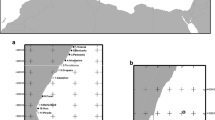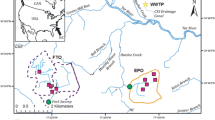Abstract
Questions have been raised about the impact of onsite sewage treatment and disposal systems (OSTDS) on adjacent water bodies, particularly in coastal areas. If OSTDS are not properly sited and maintained, they pose a potential risk to public health and may contribute toward degradation of the receiving water body. To quantify the pollutant loading contributions from OSTDS located adjacent to coastal canals, two similar single-family residential neighborhoods were evaluated. One was connected to the sanitary sewer network (Hollywood, FL) and the other was served exclusively by septic tanks (Dania Beach, FL). Water quality sampling, focusing on nutrient and pathogen indicators, was conducted at the paired sites during the seasonal high water table (SHWT) and seasonal low water table (SLWT) events. During the SHWT, measured canal water quality, in terms of nutrient (i.e. nitrate) and microbial pathogen indicators in the adjacent areas appeared to be impacted by OSTDS. However, during the SLWT, no obvious impacts attributable to the septic tanks were detected. This suggests that the OSTDS may operate properly when the water table is low, but that the contributions by OSTDS to coastal pollutant loading may be quantifiable during certain portions of the calendar year when the ground water table elevation is relatively high, although the impact on the downstream marine environment is uncertain as a result of tidal dilution and lack of offshore study.







Similar content being viewed by others
References
Alhajjar, B. J., Stramer, S. L., Cliver, D. O., & Harkin, J. M. (1988). Transport modeling of biological tracers from septic systems. Water Research, 22(7), 907–915.
Andreadakis, A. (1987). Organic matter and nitrogen removal by an on-site sewage treatment and disposal system. Water Research, 21(5), 559–565.
APHA, AWWA, & WEF (2005). Standard Methods for the Examination of Water and Wastewater, 21st Edition. Washington, DC: American Public Health Association, American Water Works Association and Water Environment Federation.
Arnade, L. J. (1999). Seasonal correlation of well contamination and septic tank distance. Ground Water, 37(6), 920–923.
Bloetscher, F., & Van Cott, W. R. (1999). Impact of septic tanks on wellhead protection efforts. Florida Water Resources Journal, 51(2), 38–41.
Bocca, T. (2007). The use of multiple tracers to determine the impact of septic tanks on the water quality of urban and rural coastal environments. A masters thesis. Florida Atlantic University, Boca Raton, FL.
Bunnell, J. F., Zampella, R. A., Morgan, M. D., & Gray, D. M. (1999). A comparison of nitrogen removal by subsurface pressure dosing and standard septic systems in sandy soils. Journal of Environmental Management, 56, 209–219.
Cable, J. E., Burnett, W. C., Chanton, J. P., Corbett, D. R., & Cable, P. H. (1997). Field evaluation of seepage meters in the coastal marine environment. Estuarine, Coastal and Shelf Science, 45, 367–375.
Coyne, M. S., Howell, J. M. (1994). The fecal coliform/fecal streptococci ratio (FC/FS) and water quality in the bluegrass region of Kentucky. Soil & Science News & Views, 15(9), 1–8.
DeBorde, D. C., Woessner, W. W., Lauerman, B., & Ball, P. N. (1998). Virus occurrence and transport in a school septic system and unconfined aquifer. Ground Water, 36(5), 825–834.
Dillon, K. S., Corbett, D. R., Chanton, J. P., Burnett, W. C., & Furbish, D. J. (1999). The use of sulfur hexafluoride (SF6) as a tracer of septic tank effluent in the Florida Keys. Journal of Hydrology, 220, 129–140.
DPEP (2001). What is the water quality in your community? 1972–1997: A resident’s guide to canal water quality in Broward county. Ft. Lauderdale, FL: Broward County Department of Environmental Protection (DPEP) Water Resources Division.
FDEP (2001). A Report to the Governor and the Legislature on the Allocation of Total Maximum Daily Loads in Florida. Tallahassee, FL: Bureau of Watershed Management, Division of Water Resource Management, Florida Department of Environmental Protection (FDEP).
FDOH (2007). Florida Department of Health. Division of Environmental Health. Retrieved from http://www.doh.state.fl.us/environment/OSTDS/statistics/ostdsstatistics.htm.
Harman, J., Robertson, W. D., Cherry, J. A., & Zanini, L. (1996). Impacts on a sand aquifer from an old septic system: Nitrate and phosphate. Ground Water, 34(6), 1105–1114.
Lipp, E. K. (1999). The occurrence, distribution, and transport of human pathogens in coastal waters of Southwest Florida. Ph.D. dissertation, University of South Florida, FL.
Lipp, E. K., Farrah, S. A., & Rose, J. B. (2001). Assessment and impact of microbial fecal pollution and human enteric pathogens in a coastal community. Marine Pollution Bulletin, 42, 286–293.
Mara, D. D., & Oragui, J. I. (1981). Occurrence of Rhodococcus coprophilus and associated actinomycetes in feces, sewage, and freshwater. Applied and Environmental Microbiology, 42, 1037–1042.
Meeroff, D. E., & Morin, F. (2005). Contribution of on-site treatment and disposal systems on coastal pollutant loading. Proceedings of WEFTEC.05, Washington, DC.
Morin, F. (2005). Contribution of on-site treatment and disposal systems on coastal nutrient loading. Florida Atlantic University, Masters Thesis.
NOAA (2007) NOAA Satellite and Information Service. Retrieved from http://www.ncdc.noaa.gov/oa/climate/stationlocator.html.
Pourcher, A.-M., Devriese, L. A., Hernandez, J. F., & Delattre, J. M. (1991). Enumeration by a miniaturized method of Escherichia coli, Streptococcus bovis and enterococci as indicators of the origin of faecal pollution of waters. Journal of Applied Bacteriology, 70, 525–530.
Postma, F. B., Gold, A. J., & Loomis, G. W. (1992). Nutrient and microbial movement from seasonally-used septic systems. Journal of Environmental Health, 55(2), 5–10.
Roeder, E. (2004). Quality assurance project plan Taylor County Health Department Coastal Community Coliform and Nutrient Study. Prepared to Taylor County Health Department, December 2004.
Scalf, M. R., Dunlap, W. J., & Kreissel, J. F. (1997) Environmental effects of septic tank systems. EPA-600/3–77–096.
Scandura, H. E., & Sobsey, M. D. (1997). Viral and bacterial contamination of groundwater from on-site sewage treatment systems. Water Science and Technology, 25(11–12), 141–146.
SFWMD (2007). South Florida Water Management District. DBHYDRO browser. Retrieved from http://www.sfwmd.gov/org/ema/dbhydro.
Sinton, L. W., Finlay, R. K., & Hannah, D. J. (1998). Distinguishing human from animal faecal contamination in water: A review. New Zealand Journal of Marine and Freshwater Research, 32, 323–348.
Tchobanoglous, G., Burton, F. L., & Stensel, H. D. (2003). Wastewater engineering treatment and reuse, Metcalf and Eddy Inc., McGraw Hill, 4th ed.
USEPA (2000). EPA guidelines for management of onsite-decentralized wastewater systems, USEPA Report 832-F-00-012.
USGS (2004). Water Resources Ground Water Data for the Nation Website; Retrieved from http://waterdata.usgs.gov/fl/nwis/gwsi/?site_no = 260120080093401.
USC (2007). Tidal level data for Port Laudania, FL: 2000–2005. University of South Carolina (personal communication).
Wilhelm, S. R., Shiff, S. L., & Robertson, W. D. (1996). Biogeochemical evolution of domestic waste water in septic systems: 2. Application of conceptual model in Sandy aquifers. Ground Water, 34(5), 853–864.
Zhang, J. Z., Fisher, C. J., & Ortner, P. B. (2000). Comparison of open tubular cadmium reactor and packed cadmium column in automated gas-segmented continuous flow nitrate analysis. International Journal of Environmental Analytical Chemistry, 76(2), 99–113.
Acknowledgment
The authors would like to thank the field staff of the FAU Laboratories for Engineered Environmental Solutions, including: Diego Meeroff, Mauricio Pico, Courtney Skinner, Pascal Cros, Felipe Pulido, Linda Hess, Eli Brossell, and Anthony Ruffini. The National Oceanographic and Atmospheric Administration Atlantic Oceanographic and Meteorological Laboratory’s Kelly Goodwin, Chuck Featherstone, John Proni, Tom Carsey, and Jia-Zhong Zhang are thanked for assisting with water quality analyses. We would also like to thank the Florida Water Environment Utility Council and the City of Boca Raton Utilities for supporting this work.
Author information
Authors and Affiliations
Corresponding author
Rights and permissions
About this article
Cite this article
Meeroff, D.E., Bloetscher, F., Bocca, T. et al. Evaluation of Water Quality Impacts of On-site Treatment and Disposal Systems on Urban Coastal Waters. Water Air Soil Pollut 192, 11–24 (2008). https://doi.org/10.1007/s11270-008-9630-2
Received:
Accepted:
Published:
Issue Date:
DOI: https://doi.org/10.1007/s11270-008-9630-2




